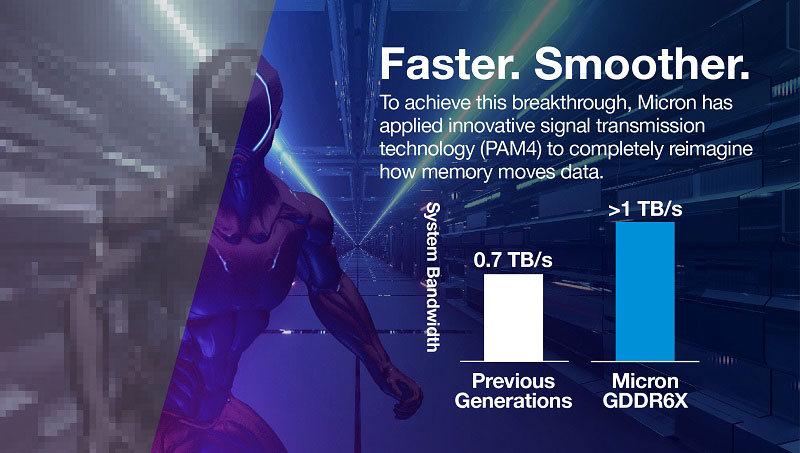Micron 16Gb GDDR6X With 24 Gbps May Debut Alongside Nvidia Ada
Memory and storage maker Micron today announced that it had begun volume production of its new 16Gb GDDR6X memory chips that run at 21 Gbps. The press release notes that these chips are destined for GeForce RTX 3090 Ti production lines. Interestingly, the firm also states that it is executing upon its product roadmap to produce 24 Gbps GDDR6X, and highlights its use of PAM4 signaling techniques for increased power efficiency.
Micron has of course already shipped modest quantities of its 16Gb GDDR6X memory running at an industry leading 21 Gbps. Existing RTX 3090 Ti graphics card review samples and retail stocks feature memory with this specification, while slower 16Gb modules are used in the RTX 3060.
With the RTX 3090 Ti graphics card being the ultimate Ampere architecture graphics card, we have to assume that the 24 Gbps GDDR6X being readied by Micron is destined for other designs. Considering Nvidia is at present the only company using GDDR6X at all, it's not much of a jump to come to the conclusion that Nvidia's next gen architecture, Ada Lovelace, will be the first beneficiary of GDDR6X at 24 Gbps. We can't rule out other possibilities, so sprinkle on some salt — just not too much.
Previously, Micron has stated that GDDR6X was built in close collaboration with Nvidia, but it says Nvidia isn't always going to be the exclusive user of this memory. In fact it says that GDDR6X is ideal for "data-hungry applications of the future," implying much wider brand / product adoption. At the time of writing, however, we don't know of any other consumer or HPC devices that use GDDR6X.
Regular readers will already know of the GeForce RTX 3090 Ti's power-thirsty reputation. Micron hints that things could have been worse if not for its "groundbreaking work with PAM4 signal transmission technology." We have discussed the advances and compromises that PAM4 features previously. In brief it can "push the bar of performance much higher while still remaining within a certain cost envelope," according to Ralf Ebert, Micron's director of the graphics segment.
Memory with PAM4 might be more difficult to build and modestly more expensive, but its extra performance and touted 15% better power efficiency provided some savings to the RTX 3090 Ti power budget. However, on the face of things, a saving of approximately 20W might not seem worthwhile, with a 450W reference spec graphics card.
Every Little Power Efficiency Helps
In related news, a recent article we published shone some light on the GeForce RTX 3090 Ti's surprising efficiency when power limited to 300W. Configured in this power restricted way, the RTX 3090 Ti was a startling 30% more power-efficient than a factory overclocked RTX 3090 GPU. Performance was observed to be on a par with an RTX 3080 Ti (which was pulling nearly 110W more).
The bigger question is how GDDR6X will stack up against other future memory types. GDDR6 modules clocked at 18 Gbps are already in production, and seem to have better overall power efficiency. Samsung has also mentioned plans to reach speeds up to 27 Gbps with its "GDDR6+" memory. Whether that's still GDDR6 or refers to future GDDR7 memory isn't clear, nor is the timeline for when such memory might become available for use.
Given we expect Nvidia's Ada architecture to arrive this fall, likely alongside AMD's RDNA 3 architecture, there's no doubt a need for improved memory speeds. And with a potential power budget of up to 600W, hopefully the future GPUs don't thrown caution to the wind and find some other ways of reducing power use.
Get Tom's Hardware's best news and in-depth reviews, straight to your inbox.

Mark Tyson is a news editor at Tom's Hardware. He enjoys covering the full breadth of PC tech; from business and semiconductor design to products approaching the edge of reason.
